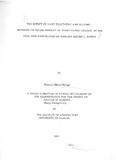Resource information
The problem of vegetation degradation in Kenya's semi-arid areas must be addressed, if these areas are to support the increasing human and livestock population. However, efforts to rcvcgctatc denuded rangelands will be beneficial only if the right species and cultural practices arc employed.
This study evaluated methods of establishing grasses in the semi-arid rangelands of Makucni District, Kenya. Three methods of land preparation and two seeding methods were compared for their effectiveness in the establishment of three range grasses. These were tractor ploughing, oxen ploughing and burning. Drilling and broadcasting as seeding methods were investigated. The grasses used were Eragrosris superba (Pycr), Cenchrus ciHaris L and Ententpogon macrostachyus (Hochst and A. Rich) Munro ex Benth. Height, tiller production and grass seedling mortality were the parameters measured as indicators of seedling establishment.
Land preparation treatments involving ploughing were significantly different from burning (P<0.1). The burned plots had the shortest plants with the least number of tillers and suffered from the highest seedling mortality. However, the burned plots had the highest density of volunteer annual grasses. There were no significant differences (P<0.1) between tractor and oxen ploughed plots. The method of seeding did not significantly affect tiller production and seedling mortality.
Significant response to seeding method was observed in height only. On average the drilled plots showed better establishment.
Response of the three grasses to land preparation and seeding was significantly different (P<0.1). Eragrostis superba had the better establishment than Cenchrus ciliaris and Erueropogon macrostachyus.
From this study, oxen ploughing was shown to have the same effectiveness as tractor ploughing in pasture establishment. Vegetation degradation can therefore be controlled if suitable species, and cultural practices which are easily adoptable are used. Oxen ploughing and broadcasting Eragrostis suprrba are recommended for the Kibwezi area according to the findings of this study.


